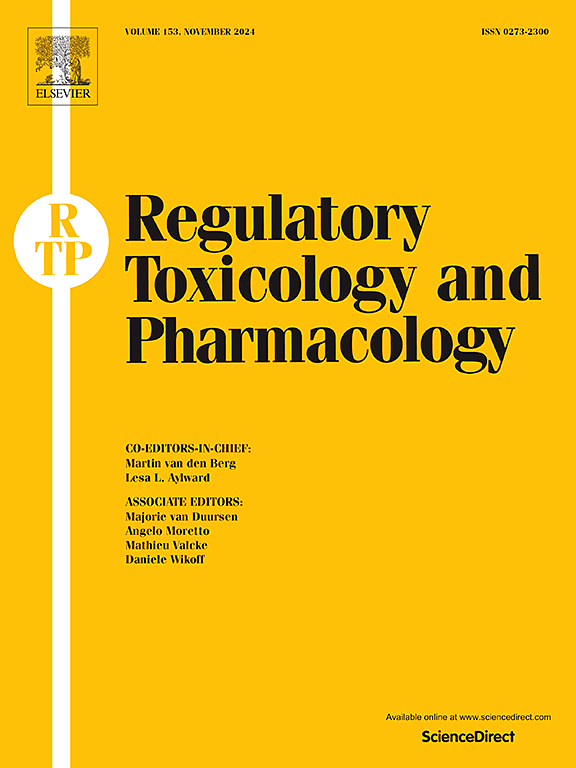Permeation studies of chlorpyrifos through skin and synthetic membranes to improve the in vitro dermal absorption assay of lipophilic compounds with ethanolic receptors
IF 3.5
4区 医学
Q1 MEDICINE, LEGAL
引用次数: 0
Abstract
The in vitro percutaneous absorption assay is standardized, but the common use of 50 % ethanol in the receptor compartment for lipophilic compounds is questioned. In parallel, the demand for animal-free methodologies is driving the application of synthetic membranes without standardization guidelines. To address these issues, this study investigated the permeation of the lipophilic compound chlorpyrifos using different ethanol-containing receptor fluids with human and pig skin ex vivo, and silicone and STRAT-M® membranes. The results considered several factors, particularly chlorpyrifos solubility and the contact angles between skin models and receptor fluids. Original experimental approaches demonstrated that ethanol from the receptor rapidly crosses to the donor compartment increasing chlorpyrifos diffusivity. Compared to the described in vivo dermal absorption, human skin and STRAT-M® yielded the best predictive permeation parameters. However, high percentage of ethanol in the receptor fluid can lead to an overestimation of percutaneous absorption. Summing up, it is important to carefully determine the concentration of ethanol to be used in the receptor fluid of lipophilic compounds’ assays while further research with synthetic membranes is needed prior to their wider adoption.
毒死蜱通过皮肤和合成膜的渗透研究,以改善具有乙醇受体的亲脂化合物的体外皮肤吸收测定
体外经皮吸收测定是标准化的,但在亲脂化合物的受体室中普遍使用50%乙醇是有疑问的。与此同时,对无动物方法的需求正在推动没有标准化指导方针的合成膜的应用。为了解决这些问题,本研究使用不同的含乙醇受体液体研究了亲脂化合物毒死蜱在人、猪离体皮肤、硅胶和STRAT-M®膜上的渗透。结果考虑了几个因素,特别是毒死蜱的溶解度和皮肤模型与受体液体之间的接触角。最初的实验方法表明,乙醇从受体迅速穿越到供体室增加毒死蜱的扩散。与所描述的体内皮肤吸收相比,人体皮肤和STRAT-M®产生了最好的预测渗透参数。然而,受体液中乙醇的高百分比可导致对经皮吸收的高估。综上所述,在亲脂化合物的受体液中仔细确定乙醇的浓度是很重要的,而在合成膜的广泛应用之前,需要对其进行进一步的研究。
本文章由计算机程序翻译,如有差异,请以英文原文为准。
求助全文
约1分钟内获得全文
求助全文
来源期刊
CiteScore
6.70
自引率
8.80%
发文量
147
审稿时长
58 days
期刊介绍:
Regulatory Toxicology and Pharmacology publishes peer reviewed articles that involve the generation, evaluation, and interpretation of experimental animal and human data that are of direct importance and relevance for regulatory authorities with respect to toxicological and pharmacological regulations in society. All peer-reviewed articles that are published should be devoted to improve the protection of human health and environment. Reviews and discussions are welcomed that address legal and/or regulatory decisions with respect to risk assessment and management of toxicological and pharmacological compounds on a scientific basis. It addresses an international readership of scientists, risk assessors and managers, and other professionals active in the field of human and environmental health.
Types of peer-reviewed articles published:
-Original research articles of relevance for regulatory aspects covering aspects including, but not limited to:
1.Factors influencing human sensitivity
2.Exposure science related to risk assessment
3.Alternative toxicological test methods
4.Frameworks for evaluation and integration of data in regulatory evaluations
5.Harmonization across regulatory agencies
6.Read-across methods and evaluations
-Contemporary Reviews on policy related Research issues
-Letters to the Editor
-Guest Editorials (by Invitation)

 求助内容:
求助内容: 应助结果提醒方式:
应助结果提醒方式:


